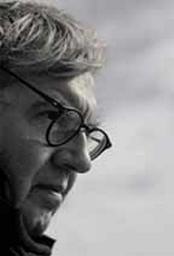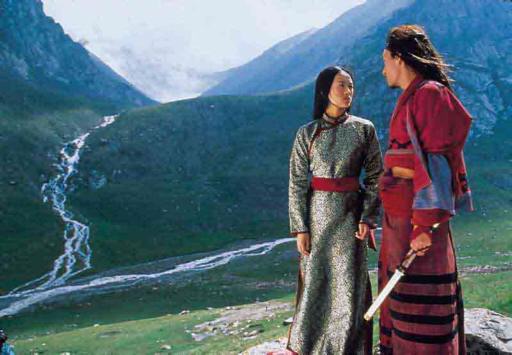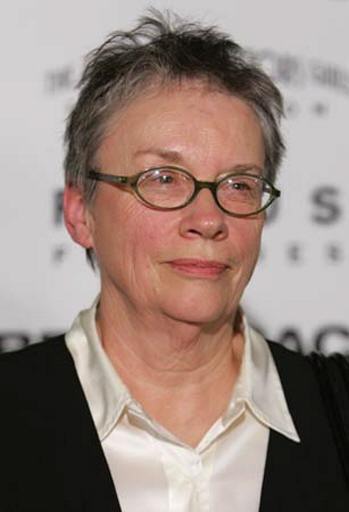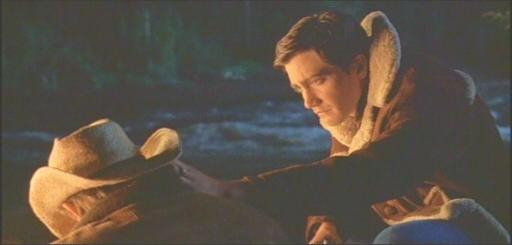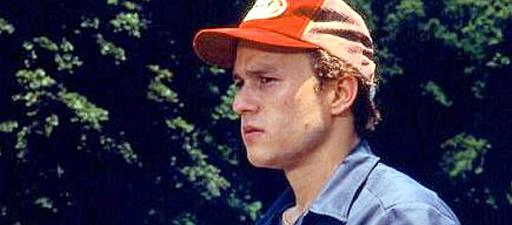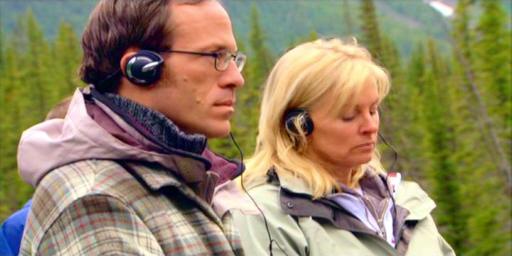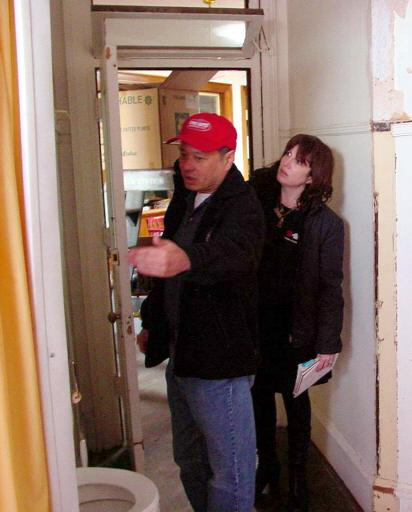I’m interested in when you started the journey and reading the piece of material, and then what you reacted to in it, what really got you about it, and then maybe take us through what it means to you now. Is there any change? I know that’s pretty heavy stuff, I’m just curious about a little bit of the journey that you’ve been through with this project. I think probably most of you know that I read the short story in The New Yorker in 1997. I was staying in Texas at the time, at Larry’s [McMurtry] big house, and a good friend of mine, one of my closest friends, was staying there with us, too. We had a couple of people there who were all writing together, and Mark [Poirier] gave me The New Yorker and said, “There’s a story in here that I think you ought to read.” He didn’t tell me anything about it, and I laid it on my bedside table. 1 I have insomnia, I can’t sleep, it’s a chronic problem I’ve had since I was a child, so I picked up the story, read it, and, it’s funny, when I first started reading it I read the first column, and it was beautiful prose but it was a western and I had been writing westerns, working on westerns, for several years, and I said, “I don’t want to read this.” I put it down, but I was still pretty wound up and I said, “Oh fine, I’ll read it.” So I read it.
Now mind you, in the collection Close Range, the collection that Annie ultimately put together with that story, there’s a prologue in that version that was not in The New Yorker, and that prologue gives you a little hint. What it sort of says is this old man is thinking about someone from his younger days, a man. But that was not in the story I read, so when I came upon the scene in the tent, when they make love, right away I thought, Oh my God, what’s going to happen to these young men? And I was racing through the story because I wanted to see what else happened. If I recall the feelings that I had when I put the magazine down, in retrospect I think what it tapped into was my own, sort of, sadness. I mean, the way that you connect with characters or a story or a film is the way that it makes you feel, and you may not recognize right away what it is about it that touches you; the humanity in it touches you. And I think what it did for me was that it tapped into my own well of grief over lost loves, or what might have been, or could have been and never was, that kind of thing. But there was something else about it, and I can’t articulate it. You see it on the screen, and you feel it when you watch the film. There’s something about it that’s very powerful, and urgent, almost, when you see it, and the feelings it gives you, you think, My God, other people need to see this, they need to feel this, they need to experience this, for whatever reason. 2 And I’ve learned so much in the last eleven years [of] my experience with this story, with this film, about people and about the human race. Somebody asked me—during the award season people would ask us occasionally—“Can you put this in one sentence?” “Can you describe this film in one sentence?” and I thought, That’s impossible. But we often had to do it for the studio or for publicity, but as time’s gone on I think my feeling about this film, [and] the one word that describes it better than anything, is “compassion.” [With] this film, more than anything, I felt compassion for these men and for this story, and I just thought and felt things, and understood things, I think, just about human nature and people, that I didn’t know before, just by reading the story. And all I could think about is that I wanted to get this thing out in the world somehow, and the widest way I could get it out would be a film. So I was very anxious to get him [Larry] to join me in writing this movie, and he’s so stubborn. Trying to get him to read this story was a challenge. You know, he didn’t want to read it because he doesn’t read short fiction, because he can’t write it. He had all these excuses. I said, “Just humor me and read the thing.” So he went upstairs and read it, and when he came downstairs he didn’t say anything, which, for Larry, is a big deal. If he’s dismissive about something right away he’ll say, “I hate it, it was awful, never mind,” but he didn’t say anything so I was thinking, Yes, this has affected him.
I’ve known this man for 23 years now and it’s really the first time, and the last time since, that he’s agreed with me right away about something. I said, “Do you think we could write a script?” and he said “Sure” and I was thinking, My God, what happened? 3 So we wrote Annie a letter right then. We wrote her a little single page, like a fan letter. We just said, “We admired your story. Would you consider optioning it to us to write a script?” And about a week later we got a letter back from her, and she said, “Well, I don’t really see a movie here, but have at it.” And so we did, and we wrote this script. And it was so much fun writing the script because when we got up in the morning we really looked forward to this because the material is so rich. And we finished the first draft and then sent it out into the world, and we began to get response immediately. Our agent sent it out, and within a couple of days Gus Van Sant flew to Texas to see us. He wanted to direct the film. And Scott Rudin came on board as a producer, and Columbia optioned it, and it just was a long, long road. I mean, the biggest obstacle was getting the Ennis character cast. We had actors who were willing to play Jack, but no one that would commit to Ennis. Why do you think that is? What was the thing that was so difficult about this man? Well, what Larry and I figured out was that the representatives for these actors, and there were several major, young film actors, but when push came to shove their representatives just dissuaded them from it. Because they would hang onto the script for three or four months, and they wanted to do it, wanted to do it, thought it was the most amazing script they’d ever read, blah, blah, blah, blah, blah. But when it came down to signing the contract they would just back away, so...that was what we figured. So how did Ang Lee come to be associated with the project? How did it end up away from Columbia? Oh, well, their option ran [out] and then somebody in Scott Rudin’s office didn’t calendar the option—and I’m sure they’re buried in Mexico somewhere—the option ran, and Annie wouldn’t renew the option to him because she didn’t feel he was working hard enough. Annie would get discouraged, and Larry just kept saying to me, “Diana, don’t worry.” Larry doesn’t worry about anything; he’s not a worrier. He said, “It’ll find its way.” I’m trying to remember now exactly. James Schamus was with Good Machine, and he read the script and they optioned it from us for about $5000, I think, and he sent it out to about four or five different directors. The only director who really expressed any interest was Joel Schumacher and, as it turns out, I think he pretty much just wanted to meet Larry, which he never got to do. Larry was disgusted with him because he didn’t make any movement forward with it. Shortly before Ang did The Hulk was right about when James’ option was going to run, just a couple of weeks before the option was going to run, and I had seen Crouching Tiger, Hidden Dragon at the theater, so I called him up and I said, “James, why don’t you show the script to Ang?” Well, before I even did that I had Larry see the film and he agreed, at least visually, because Annie was very concerned about this, as were Larry and I, that we would lose the landscape. We wanted the landscape, that great vastness of the West, and the intimate stories as well, and that’s what Crouching Tiger was, the huge Mongolian plain and these intimate stories of repressed love. And, of course, I loved The Ice Storm, you know, which is Ang’s film, too. 4
Anyway, so a couple of weeks later James called me back and he said, “Well, you know, Ang read the script and he really liked it, but we’re going to do The Hulk.” And I said “Okay...well...gee...” So that came and went. Larry and I used to get letters and cards and messages from people who had read the script, just random people, actors and agents, and they’d say, “Oh my God, it was an amazing script” and I would respond and say, “Okay, what are you going to do about it? Are you going to do anything about it?” And they’d say, “Well, uh...” and we’d say, “Fine, yeah, we know it’s good, so never mind.” I just had to be relentless about it, and I couldn’t not think about it because we believed in it so strongly. I did, too. I just thought it was an amazing story...powerful.... You talked about Annie before, being worried. Were you concerned about her reaction? Were you getting feedback from her? No. Larry and I finished our first draft, finally, after about three or four months, and then we sent Annie a copy to read, as a courtesy. We wanted to know what she thought, but we weren’t afraid or anything. And Annie called, and I talked to her on the phone for a couple of hours. We went through the script, and there were just a couple of things, like a word here or there that she thought the character might say this in Wyoming instead of this word. We did that, and then we had some discussions about the scene where Ennis goes into the gangway [alley] after he and Jack part on Brokeback. In the script I say something about his “stinging tears,” and she said Ennis wouldn’t cry, and I said, “Well, you know, Annie...” and I started to explain to her why I thought he might. I said, “He’s 19, he’s young, he has these feelings that he doesn’t know where the hell they’ve come from or what they mean; he thinks he might have had a bad meal. But he’s just full of this emotion, so I think it would seem appropriate if it happens, if the actor does it or he doesn’t, but you know, I’m very concerned that he doesn’t cry a lot in the film because when we see him at the end it needs to have an impact.” 5
Oh, and the other thing she said—this is funny—is in the last scene when Ennis takes that bottle of wine out of the refrigerator in the trailer. She said, “Oh, whiskey-drinking Ennis wouldn’t have wine” and I said, “Oh, that’s just a bottle that Cassie left there two years ago” and she said, “Oh, that’s great, I love that!” So, you’ve lived with these characters? Oh my God, have I! Talk about the first draft of the script, and then what we see on the screen. How much of a change did you go through? Did you go through rewrites or is it pretty much as you originally conceived it? What were some of the things that were brought to it in the development stage? Well, the script really didn’t change very much at all through the years it went through Gus, and James, and company. When Ang got it we had some discussions right away about it. Ang seemed very concerned about the scene where Alma sees them kiss. He felt it was too much, and that the audience would be so shocked by this that there would be sort of a sag afterwards that they wouldn’t recover from. Larry and I were a little baffled by that. I mean, we understood the concept he was talking about, but we didn’t understand why he felt this. So I asked him, “What do you think about the sex scene?” and he said, “Oh, that doesn’t bother me, but when we first see them kiss, it’s not such a good idea.” 6 So, it took me about three weeks. I wrote this letter explaining all the reasons why she had to see them kiss, and I was very nervous about this, because, my God, that’s a pivotal scene in the film; so much hinges on that. And one of the things that struck me about the story, right away, the first time I read it, was that I kept imagining in my head, What are the wives thinking? What are these two children...? What are these two men...? Their relationship did not happen in a vacuum, you know, there’s a big picture here that is interesting, and I’m curious about it, and how they’re affected by it, and how the people around them are affected by it, what this means in the world, you know? So I wrote him a letter and I just explained all the reasons why, and he read the letter, and called me, and said, “Okay.” And I’d written him...we’d made a couple of changes in the script, so I did two different versions of the script, I have them on my computer, one that says “sees kiss” and one that says “doesn’t see kiss” and he didn’t even look at those. He just read the letter and he said fine. So, that was a relief. I think a couple of major changes—well, what we felt were major—the scene where, after they see each other again, after four years, and Ennis and Jack leave to go camping, you know, the dialogue that takes place at their little campground there, around the fire. Annie had placed it in the motel room, we had it there, and Ang wanted to separate it out and, I think, put it in a more pastoral setting; we’re not certain. Larry and I just assumed because it was kind of a western, and he wanted it more pastoral, so we made that change; we shifted that to the outside.
We added the scene where Ennis comes back and gets his things together and Alma’s there, because that was not in our original script. I think we felt that might almost be too cruel, but we put it in, and I think that’s pretty much it for changes. 7 Let’s talk about when you finally get the whole thing together, and you’re going to Canada and Larry’s staying home, and there you are with the troupe up in Canada, and you’ve got this cast. Talk about what the production process was like, and also your sense of seeing the word come to life, basically. That’s really hard to put in a nutshell. Maybe we can get more specific questions from people out there. Talk about the casting process first. Well, we went through lists of girls for the Anne Hathaway and Michelle Williams parts. We had lists of women, and we all had our pick. So, when the list for Alma came around and I saw Michelle Williams on it, I thought that was a great choice, because I’d seen her in Dawson’s Creek, and I wondered, What the hell is this girl doing on this show? She’s so good and she’s head and shoulders above the other actors on here. She just didn’t fit. So I just felt we were very lucky to have her. And Ang had never seen Dawson’s Creek, he’d never seen her in anything. She just came and auditioned, the same as Annie Hathaway. He didn’t know what she’d done before, and he just chose those two girls based on what he saw when he met them.
8 Joaquin Phoenix had actually expressed interest for a long time in playing Jack, and he came in, and I think he was choosing between Walk the Line and this. I think he got the part for Walk the Line before Ang made his decision, and we had Jake. But Larry and I had wanted Heath for several years. My daughter, in fact, brought him up to me, I think that was about in the year 2000, and she said, “Mom, you really ought to look at his work,” so we had a little festival of his movies. I thought that he was a very interesting looking actor, and I loved the fact that he was Australian because I thought it might bring a different sort of, you know, not having an American actor would bring more of an outsider’s point of view to this. Plus, there was something behind his eyes, there was something very intelligent. He seemed like a really fine actor in some not-so-fine movies...you know how you see that sometimes. And then Monster’s Ball came out and I said, “Okay, now I’ve got to show this to Larry.” So I made him sit down and watch the movie. He sat there and he watched it until the young man kills himself, and he sat there for a few more minutes and again he didn’t say anything, and then he said, “I don’t want to watch anymore, just turn it off.” So I turned off the movie, and he just stood up and he looked at me and he said to me, “That young man’s Ennis” and he walked off. So I thought, Well, okay, now I’ve got Larry.
Then my friend Michael Costigan called me out of the blue, and he said that he had just randomly read the script. He said that it sat on his desk for three months. “It was called a gay cowboy movie and I thought it was a joke, but I didn’t have anything else to do last night so I sat and read the script, and it broke me in half. And then my fiancé read it, and she was devastated. You have to make this movie.” And I said, “Sure, I know that.” And he said, “What can I do to help?” And I said, “Well, if you want to come on board great, but there’s no money, I’m just telling you that, there’s no money to be had, yet, and maybe someday there will be, but you’ve got to commit to this.” 9
So we set out to do this together and sent it to various people, I think Edward Norton as the director. A lot of people looked at it and really loved it, but again, they just backed away from it. And then, like I said, The Hulk just sort of came and went, and at that point Schamus had formed Focus Features and was now the head of the studio, and Michael and I got on the phone, and I said, “Michael” and he said, “Well, I can talk to John Lyons over there. What do you think? Should we send the script back there?” And I said, “Yeah, let’s just send it over there again and see what happens.” I mean, The Hulk? I can’t even imagine Ang being happy doing that movie, but I don’t know. It just didn’t seem like his kind of movie. Although, I thought the visuals on it were really interesting. But anyway, we sent it over there, and within three weeks we were making a deal. So, that’s how Ang came on board. 10
Judy [Becker] was supposed to be here to talk about production design. Oh yeah, Judy; she’s great. We just love her. She’s such a character, and she’s so spot-on about things. She grew up in New York, but she’s so instinctive. We took Ang and Judy to Texas and showed them around over there where Larry grew up, showed them the ranch house where he grew up, just kind of so they could absorb things, showed them pictures of Larry’s family. Larry’s father and his eight uncles were all ranchers, and Larry was a cowboy, too, until he was 22, when he became a writer. So they just absorbed that, and Judy especially. Then we sent them up to Annie [in Wyoming] and I think Ang spent one day with Annie, but Judy just drove all over the state of Wyoming. And then we sent them some books, and we talked about them. I had Richard Avedon’s [1] book, In The American West, and showed them those pictures, and there’s a fellow in there, there’s two pictures of him, he’s very young and then just 12 years later, and he looked 20 years older, and that’s sort of the look that we had based Heath’s look on in the film. If you could see those pictures, you’ll see why. [1] For a short article discussing
Richard Avedon’s work, written by Annie Proulx, see 11
Judy was just great. We sort of made this film a family affair, mainly because we didn’t have any money, and so my daughter worked with Judy as a production assistant on the film. It was the first day of shooting, and it was the day that...we filmed two scenes that day. There was the one on the toboggan, and the Thanksgiving scene in the house where Alma was with Monroe now, and they had that confrontation in the kitchen, and we walked into the house and [my daughter] said, “Judy, don’t these people mind us being in their house? Look at all their stuff.” And Judy said, “That’s OUR stuff,” but it just looked so real. And the great thing about Judy’s production design—she did that Zach Braff film Garden State—if you see her production design it’s so much a part of everything that it doesn’t stand out. You feel as if you’re a voyeur, that you’re looking in on these people’s lives, that you’re really in their home, that you’re really in their lives, and that’s what’s so great about her production design. She’s terrific. 12
Talk about the actual shooting. Was there a lot of discussion, or changes in the script, or did everyone pretty much approach it as it was? Oh, yeah. Well, the one thing I didn’t finish, the casting, Heath, for example. Heath was not the first actor who committed to the role. Another actor committed, and Larry and I had suggested Heath, but the studio didn’t feel that he was macho enough. [Mumblings from the audience.] We were sort of Okay, okay, and Ang auditioned actors, and he chose an actor and the actor committed, but for some reason I just had this sense that this young man was not going to...I thought he was going to drop out. And I was talking to...I have a good friend who worked with Heath on Brothers Grimm and had been talking to Heath about the role, and then I was also talking with Heath’s agent, Steve [Alexander] and I were talking, and I kept calling him saying, “Just hang in there, hang in there, hang in there. I think that something’s going to happen.” This was in, I think, August, that the actor committed, and by December, right before Christmas, sure enough, he dropped out. And I called Heath’s agent and I said, “Okay, get him a script.” So they got him a script to New York, and he and Naomi [Watts] read it on their way to Australia for their holiday, and when we got to the set Heath told me, “You know, I read the script and I wanted to do it, and Naomi read it and she was jumping up and down on the bed saying, ‘Heath, you have to do this movie, you have to do this movie.’ I would have flown to Taiwan for 20 hours just to meet with Ang, because I wanted to be in this movie. Once I read the script, I just wanted to be in the film.” So Heath and Ang met, and Ang instinctively said, “Yes.” 13 So what about the shooting in Canada? Was that problematic at all? Ang seemed to indicate that everything went very smoothly. I had worked with a lot of the people on our crew before, because I had done three miniseries up there. I’d already filmed 18 hours of movie up there, so I knew our wranglers, and I knew our transportation people, and I knew our locations scout. I knew a bunch of the folks already, and I knew how great they were.
It was a very smooth production in terms of our crew. We had an amazing crew. They worked so hard and never complained. We had 26 different locations and, technically, 42 shooting days, which is insane to move everybody and do all the things that we did. Everybody was, and I know this sounds Pollyanna-ish but it’s the truth, they were so committed to this. When I got there, within the first two weeks, every person on the crew had come up to me at some point and said how grateful they were that they were working on this film, and how much it meant to them, and how wonderful the script was. A couple of the people on the crew came out to me within the first week, and it was just like we were all drinking the same Kool-Aid, you know? It was really strange, but it was wonderful in that regard. And everybody worked their butts off. I shared my set trailer with three guys, and it was tough, and I got pneumonia while we were making the film, but I suffered through that and kept going. The place where we filmed actual Brokeback Mountain, those scenes, no one had ever filmed there before [Moose Mountain]. The road was 45 minutes in, it was a two-hour drive and then you had to go 45 minutes in four-wheeling, but you could only go in, or out, because the clearing was so narrow, so that was quite a challenge. 14 [Part 2 of this transcript is available here.] |


